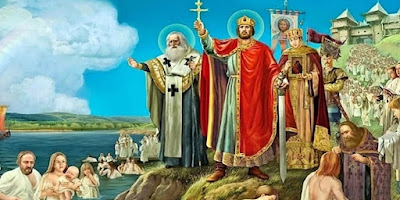In its native language its title translates to the "Tale of Bygone Years," derived from the opening lines of one of the extant early manuscripts: "These are the narratives of bygone years regarding the origin of the land of Rus', the first princes of Kiev, and from what source the land of Rus' had its beginning."
Traditionally, it was also referred to as the "Nestor Chronicle" because it was believed to have been written by a monk called Nestor, but later scholarship has suggested that it is a compilation and not the work of a single author. Also, the chief evidence for Nestor's authorship seems to be the name Nestor (нестера) inserted into a later edition. A likelier author is Sylvester of Kiev (c.1055 - 1123), an assistant abbot of the Vydubetsky Monastery in Kiev.
There are five (maybe six: one from 1450 was destroyed in a fire in 1812 and "reconstructed" from memory; it is considered unreliable) early manuscripts used to study the Primary Chronicle, the earliest of which is more than two centuries newer than the original, so we have no idea what exactly the original would have looked like, or what changes were made by well-meaning copyists and editors. The Laurentian Codex (shown above; you can read the whole thing and scholarship about it here) is the oldest version we have, from 1377. It continues the history through 1305, but some years (898–922, 1263–83 and 1288–94) have been inexplicably left out.
The Primary Chronicle includes many anecdotes, including the founding of Kyiv and the manner that St. Olga got revenge on the Drevlians after they murdered her husband. Some of the history, however, contradicts other chronicles, including some writings by the aforementioned Nestor the monk. Nestor was real, and the temptation to link him to the Primary Chronicle is understandable, since he wrote many things around the time of the original. In fact, we should talk about Nestor tomorrow.



